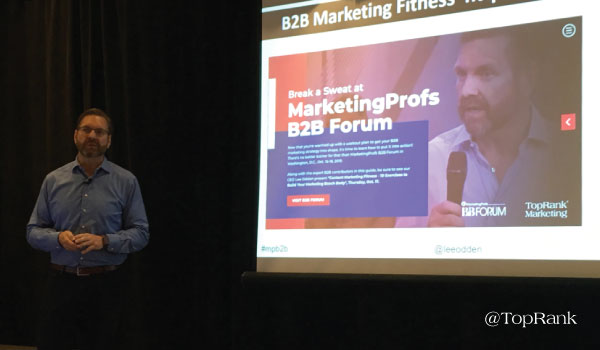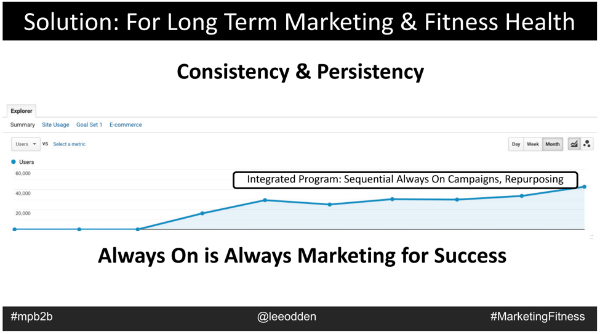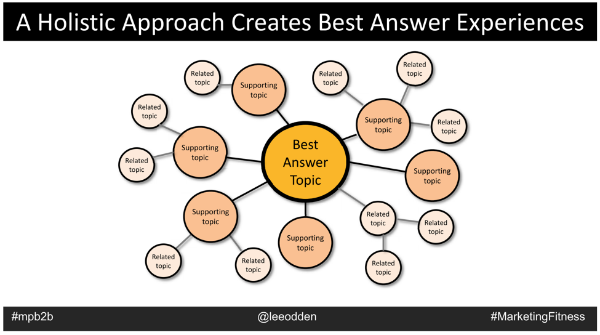
On Thursday morning at MarketingProfs B2B Forum, TopRank Marketing CEO Lee Odden asked a room full of marketers, “Who here has tried starting a diet or exercise program before?” Pretty much every hand in the room shot up.
The percentage of those individuals who would rate their efforts as a satisfying success? Not quite so high.
Falling short of aspirations with fitness endeavors is an almost universally relatable experience. We embark on a diet plan, but we slip. We go all-in on a workout regimen, but we stop. Life gets in the way, and other priorities demand our attention. Alas, any temporary progress we make ultimately proves to be only that.
Many marketers are familiar with this pattern in their jobs: Campaigns yielding strong results, which quickly fade and leave us unfulfilled.
What are the keys to getting over the hump? In his MPB2B session on building a marketing beach body, Lee pinpointed some of the most prominent obstacles and offered advice on overcoming them.
Barriers and Breakthroughs for Healthy B2B Marketing
After confronting his own health issues and shedding 65 pounds in the course of a year, Lee had a revelation: “It’s not about the goal, it’s about the journey.” He says that once he stopped focusing so intently on the number he wanted to see on the scale, and instead started emphasizing daily discipline, the rest took care of itself.
This inspired the theme of his MPB2B presentation. Marketers can get so caught up in KPIs and the relentless pursuit of results that we lose sight of the incremental steps along the way.
In particular, there are a number of pervasive roadblocks he’s seen in the B2B marketing world. He shared his perspectives on overcoming them and staying on track for sustained success.
The Barrier: Campaigns Deliver Only Bursts of Short-Term Impact
Starts and stops: the enemy of any fitness initiative. We go hard at the gym for a month and then we fall out of the routine, only to see those lost pounds tack right back on. This same problem plagues campaign-based marketing strategies. We come up with a great idea and execute it, but the business impact is fleeting.
The Breakthrough: Sustained Growth with Always-On Marketing
There’s nothing wrong with campaigns, necessarily, just like there’s nothing wrong with a concentrated bunch of trips to the gym or a week of hardcore dieting. The key is to not completely take your foot off the pedal and erase momentum at the conclusion. For B2B brands, that means combining campaigns with an always-on marketing strategy. Campaigns should be sequential and build upon one another.

The Barrier: Scattered Tactics and Channels Yield Scattered Results
There are so many weight loss fads and trends out there it can be hard to keep up. As such, people are prone to sporadically trying out different ones with little cohesion – a two-day fast here, a juice cleanse there. Ohhh, look, a ketones supplement!
Shiny object syndrome can also distract marketers. Should we do an eBook, or webinar, or event? Which channel should we focus on – email, social, search? Blindly throwing darts won’t often result in a bullseye.
The Breakthrough: Connect Your Approach with an Integrated Strategy
Every tactic and channel should make sense within the big picture of your strategy, aligning with your audience’s preferences and your ultimate goals. In the scope of a data-driven always-on program, it becomes much easier to identify the right tactics and channels for the right initiatives.
The Barrier: Lack of Resonance and Traction with Buyers
The old SEO playbook called for a relatively simple formula: Chart out the keywords relevant to your product or service area, and then create content to rank for them. It’s as straightforward as an-apple-a-day. The problem is that it’s not very effective anymore in an evolving digital environment.
The Breakthrough: Empathetic Content Planning Driven by Customer Insights
“Last I checked, Google doesn’t pay my bills, but actual humans,” Lee quips. Don’t let keywords guide your marketing strategy; let your customers guide it. Instead of planning your content around words or phrases you expect buyers to search for, plan it around the questions (and derivatives of those questions) they ask throughout their research and purchase journeys. The more expansive your coverage of these curiosities, and the more definitive your answers, the more comprehensive your best-answer approach.

The Barrier: Our Brand Is Struggling Gain Credible Visibility with Decision Makers
Even with a well-conceived best-answer strategy, it can still be difficult to earn the attention of influential members on buying committees, especially in competitive categories. That’s just a reality of the world we now live in, much like the abundance of processed food steepens the challenge of dieting. Surrounded by content saturation and “banner blindness,” we must find new ways to credibly convey our values and expertise.
The Breakthrough: Collaborations with Respected Influencers
No matter what industry or niche you operate in, there are influential voices that already have the respect and attention of the people you want to reach. Creating mutually beneficial partnerships with topically relevant influencers holds the key to growing targeted brand awareness, with a built-in level of trust.
“When people find you, you want to make sure that what they find is super credible,” Lee says.
Long-term engagements, founded on solid relationships and strengthened through an always-on influencer strategy, will help you steer clear of stops and starts on this front.
The Barrier: Content Engagement Fizzles Out Too Quickly
You’ve created something awesome. People love it. The investment seems to be paying off. Yet, after a few weeks, it’s been all but forgotten. Marketers frequently fall into the trap of putting tremendous effort and resources into creating great content, but comparatively little into promotion, and doing themselves a major disservice.
The Breakthrough: Build in Promotion and Repurposing from the Start
“I think the best promotion is baked into the content planning process,” Lee opines. Don’t make this crucial aspect an afterthought. Choose channels and influencers ahead of time that aligns with the planned content asset in question, and tailor your messaging for each. Create a staggered promotion plan for continual bursts of exposure and engagement. Get creative with your techniques: email blasts, LinkedIn videos, forum shares, guest blog posts, social ads, etc.
Oh, and repurpose that baby! Almost every piece of content offers a wide range of opportunities for being sliced up in different formats and styles. Keep in mind that different folks in your audience like to consume content in different ways. Consider taking your central premise (or “universal truth,” as Lee puts it) and recreating it with angles speaking to various specific verticals you serve. It’s an efficient yet effective way to personalize and resonate more deeply.
Putting It All Together
“We’ve all tried diets, and we’ve all tried exercise,” Lee remarks. “We know what to do. It’s just a matter of finding a way to put it all together and staying on track.”
Easier said than done, as we all know. But by eliminating bad habits and conquering small goals in the name of greater achievements, it can be done. That applies to marketing just as well as fitness.
We know what to do and what we want to accomplish. Putting it all together with a holistic, integrated, always-on strategy will help eliminate the stops, starts, and setbacks.
The Extra Mile
We asked Lee a few additional questions for further insight on B2B marketing fitness. Here’s what he had to say about rigid formulas, overlooked techniques, and the pitfalls of one-off campaigns.
“All things in moderation,” is a reasonable motto for both wellness and marketing. But are there any metrics or tactics you think should be simply cut from our routines?
Many marketers rely on formulas and best practices for their marketing because they provide efficiencies for execution and hopefully effective outcomes. However, without any connection to evidence that buyers actually care about a particular type of content or channel, marketers need to consider whether the tactic is worth keeping or cutting.
Which techniques are being overlooked too frequently in efforts to strengthen and grow our marketing programs?
Vast amounts of B2B content is created based on what the brand wants to promote vs. what buyers want to know. B2B marketers need to reflect on their approach and decide if making information or delivering answers that buyers are actually looking for will achieve marketing programs with long-lasting strength.
Techniques being overlooked include:
- Understanding customer preferences for information discovery – where do they subscribe, who influences their opinion, what events do they attend, what publications do they read, what do they search on, what social conversations are they having, and what industry associations and special interest groups are they a part of? With that insight, brands can create more relevant content in the channels where buyers are.
- Understanding buyer preferences of content formats – text, video, audio, images, interactive. Also topics and types – research, case studies, how to’s, thought leadership, infotainment. Last, devices used to consume content – mobile, tablet, desktop, wearable devices. These preferences can help marketers deliver the most relevant and meaningful content experiences.
- Understanding the triggers that will motivate action. Not every interested visitor is ready for a transaction, so it’s important for brands to map the buyer journey and understand the needs buyers have to take the next step, wherever they are in the journey from awareness to consideration to transaction.
Can you cite any scenarios where short-term tactical efforts fail to make a real impact due to a lack of strategic follow-through (like a burst of weight loss that is quickly erased)?
The ephemeral nature of the social web plus distracted and distrustful buyers makes one-off content marketing campaigns meant to build credibility, thought leadership and authority a lost cause. Buyer perception cannot be turned on or off like a light switch. Marketers need to be “on” when it matters and that might have to mean always on. To become “the best answer” for customers about a topic they care about and that your brand wants to represent, it takes an always-on approach to marketing. That means an ongoing effort to create content on topics and in formats customers care about and promoted in the channels where they spend time. Always-on content is more like a conversation than pontification between a brand and its community of buyers.


